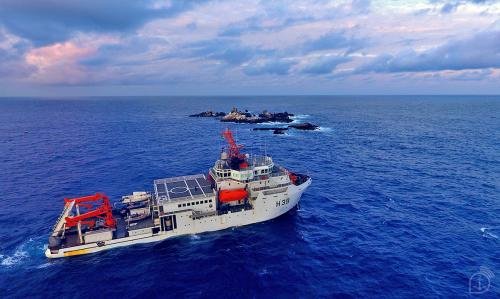Despite not having large dimensions, the set of isolated rocky islands in the middle of the Atlantic Ocean, known as São Pedro and São Paulo, located about a thousand kilometers off the Brazilian coast, attracts more and more scientists in search of discovering its natural riches. And the interest is not new. The most famous visitor to the islands was Charles Darwin in 1832, during a trip around the world that culminated in the development of his famous theory of evolution.
The archipelago has a total surface area of approximately 17 thousand m², equivalent to more or less two football fields. Although small, the rocks have a rare formation and are surrounded by rich biodiversity, which provides unique conditions for conducting research in various branches of science.
Earlier this month, the Brazilian Navy (MB) Hydroceanographic Research Vessel “Vital de Oliveira” took 23 researchers selected by the Ministry of Science, Technology and Innovation (MCTI) to collect data from scientific projects that seek to better understand the that is taking place around the islands.
During a period of 15 days, researchers from the Federal University of Rio Grande (FURG), Fluminense Federal University (UFF), Federal University of Rio Grande do Norte (UFRN), Federal Rural University of Pernambuco (UFRPE), Federal University of Santa Catarina (UFSC), University of Vale do Rio dos Sinos (UNISINOS) and University of São Paulo (USP) were on board the Navy ship, with attention focused on this remote area of the Blue Amazon.
The diversity of institutions, from different regions of the country, proves the importance and interest in this distant part of the national territory. Among the activities developed by the ship and the researchers in this mission, the following stand out: the study of persistent organic pollutants; monitoring of seismic activity and bioacoustic emissions; ocean floor imaging (a technique that generates images mapping the molecular composition of a given material); the characterization of fungi present in deep marine sediments of the Atlantic Ocean, with collection of samples at more than 4 thousand meters of depth; the evaluation of ecological factors and anthropic pressure acting on seabirds; the monitoring of marine biodiversity in Brazilian oceanic islands;
Selection of projects The Technical Assistant of the General Coordination of Ocean, Antarctica and Geosciences (CGOA) of the MCTI Iran Cardoso Júnior explains that, in the case of expeditions coordinated by the ministry, the agency carries out a consultation with researchers who have projects already approved by the Council National Institute for Scientific and Technological Development (CNPq) or by the Coordination for the Improvement of Higher Education Personnel (CAPES), to facilitate the demand for embedded research. The process is carried out in conjunction with the Navy, which will analyze the logistics issue.
“We started to study with the personnel of the Group of Hydroceanographic Vessels the feasibility of the project, if those intended areas are feasible, if the vessel has equipment capable of meeting certain demands”, highlights Cardoso.
In order to make the process more transparent, in August this year the MCTI launched a public consultation to identify the demands of the scientific community that want to use research vessels. Interested parties have 30 days, counting from the date of publication of the public notice, to present projects that require the support of the ships.
For the Commander of “Vital de Oliveira”, Frigate Captain Daniel Peixoto de Carvalho, “the operation of a military environment with modern research equipment available to the scientific community produces a fundamental synergy for the exploitation of natural resources, being an excellent vector in the direction of Brazilian prosperity and sovereignty”.
Professor Arthur Ayres is one of the researchers who was aboard the ship “Vital de Oliveira” bound for the archipelago. He conducts the research “Characterization and Biotechnology of fungi present in deep marine sediments in the Atlantic Ocean along the Brazilian coast”, coordinated by UFMG in partnership with UFF.
According to the expert, research in this area helps to understand in advance what is happening with the health of the ocean and what is impacting marine fauna and flora. He explains that, in addition, it is also possible to carry out studies that can contribute to the development of natural resource management, to biotechnological exploration (such as the production of pharmaceuticals), to geological and seismic studies (to the research of mineral resources) and for the preservation of endangered species.
According to the coordinator of the “Sentinels of the Blue Amazon” project, professor at UFRN Renata de Sousa-Lima, who carries out bioacoustic research on cetaceans off the Brazilian coast, “the opportunities to carry out research in the region are scarce, as it is a difficult location. access and, therefore, with little known information. The fact that it is a little explored area makes participating in the expedition even more special”. The vice-coordinator of the project, Manuela Bassoi, who studies the distribution of these animals between the coast of Rio Grande do Norte and the ASPSP, reports that each opportunity to explore this region is unique. “The partnership with the Navy has helped us a lot in this regard”, she concludes.
The archipelago is at a critical point for navigation, as the islands are not easy to detect with the naked eye, especially in adverse light and weather conditions, which has caused some shipwrecks throughout history. The origin of the name of the islands is precisely a reference to a rescue carried out there of sailors who had fallen from the Portuguese vessel São Pedro and were rescued by the Portuguese caravel São Paulo in 1511.

